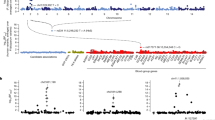Abstract
We examined a possible association of single-nucleotide polymorphisms (SNPs) in the promoters of IL-3, IL-4, and IL-13 genes on the 5q31–33, IL-3 −16T>C, IL-4 −590T>C, and IL-13 −1055C>T, with severity of malaria in 361 adult malaria patients in Thailand. The IL-13 −1055T allele showed a significant association with protection from severe malaria (OR 0.51, 95% CI 0.32–0.80; P=0.0032 by the χ2 test), while allele frequencies of IL-3 −16T>C and IL-4 −590T>C were not statistically different between mild and severe malaria patients. An IL-13 −1055C>T has been reported to alter the regulation of IL-13 production. Thus, IL-13 −1055T may show resistance to severe malaria through the alteration of IL-13 production.
This is a preview of subscription content, access via your institution
Access options
Subscribe to this journal
Receive 6 digital issues and online access to articles
$119.00 per year
only $19.83 per issue
Buy this article
- Purchase on Springer Link
- Instant access to full article PDF
Prices may be subject to local taxes which are calculated during checkout
Similar content being viewed by others
References
de Kossodo S, Grau GE . Role of cytokines and adhesion molecules in malaria immunopathology. Stem Cells 1993; 11: 41–48.
Malaguarnera L, Imbesi RM, Pignatelli S, Simposre S, Malaguarnera M, Musumeci S . Increased levels of interleukin-12 in Plasmodium falciparum malaria: correlation with the severity of disease. Parasite Immunol 2002; 24: 387–389.
Rihet P, Traoré Y, Abel L, Aucan C, Traoré-Leroux T, Fumoux F . Malaria in humans: Plasmodium falciparum blood infection levels are linked to chromosome 5q31–q33. Am J Hum Genet 1998; 63: 2–9.
Marsh D, Neely JD, Breazeale DR et al. Linkage analysis of IL4 and other chromosome 5q31.1 markers and total serum immunoglobulin E concentrations. Science 1994; 264: 1152–1156.
Meyers DA, Postma DS, Panhuysen CI et al. Evidence for a locus regulating total serum IgE levels mapping to chromosome 5. Genomics 1994; 23: 464–470.
Marquet S, Abel L, Hillaire D et al. Genetic localization of a locus controlling the intensity of infection by S. mansoni on chromosome 5q31–q33. Nat Genet 1996; 14: 181–184.
Müller-Myhsok B, Stelma FF, Guissé-Sow F et al. Further evidence suggesting the presence of a locus, on human chromosome 5q31–q33, influencing the intensity of infection with Schistosoma mansoni. Am J Hum Genet 1997; 61: 452–454.
Yamada R, Tanaka T, Unoki M et al. Association between a single–nucleotide polymorphism in the promoter of the human interleukin-3 gene and rheumatoid arthritis in Japanese patients, and maximum-likelihood estimation of combinatorial effect that two genetic loci have on susceptibility to the disease. Am J Hum Genet 2001; 68: 674–685.
Rosenwasser LJ, Klemm DJ, Dresback JK et al. Promoter polymorphisms in the chromosome 5 gene cluster in asthma and atopy. Clin Exp Allergy 1995; 25: 74–78.
Luoni G, Verra F, Arcà B et al. Antimalarial antibody levels and IL4 polymorphism in the Fulani of West Africa. Genes Immun 2001; 2: 411–414.
van der Pouw Kraan TCTM, van Veen A, Boeije LCM et al. An IL-13 promoter polymorphism associated with increased risk of allergic asthma. Genes Immun 1999; 1: 61–65.
van der Pouw Kraan TCTM, Küçükaycan M, Bakker AM et al. Chronic obstructive pulmonary disease is associated with the −1055 IL-13 promoter polymorphism. Genes Immun 2002; 3: 436–439.
Ohashi J, Izumi Naka, Patarapotikul J, Hananantachai H, Looareesuwan S, Tokunaga K . Significant association of longer forms of CCTTT microsatellite repeat in inducible nitric oxide synthase (iNOS) promoter with severe malaria in Thailand. J Infect Dis 2002; 186: 578–581.
Terwilliger JD, Ott J . Handbook of Human Genetic Linkage. The Johns Hopkins University Press: Baltimore, 1994, pp 188–193.
Lewontin RC . The interaction of selection and linkage. I. General considerations; heterotic models. Genetics 1964; 49: 49–67.
Acknowledgements
We sincerely thank the patients who participated in this study. This study was supported by the Core University System Exchange Programme under Japan Society for the Promotion of Science, coordinated by the University of Tokyo and Mahidol University, The National Research Council of Thailand, and a Grant-in-Aid for Scientific Research on Priority Areas (C) ‘Medical Science’ from the Ministry of Education, Culture, Sports, Science and Technology, Japan (to JO).
Author information
Authors and Affiliations
Corresponding author
Rights and permissions
About this article
Cite this article
Ohashi, J., Naka, I., Patarapotikul, J. et al. A single-nucleotide substitution from C to T at position −1055 in the IL-13 promoter is associated with protection from severe malaria in Thailand. Genes Immun 4, 528–531 (2003). https://doi.org/10.1038/sj.gene.6364010
Received:
Revised:
Accepted:
Published:
Issue Date:
DOI: https://doi.org/10.1038/sj.gene.6364010
Keywords
This article is cited by
-
Neuregulin-1 attenuates mortality associated with experimental cerebral malaria
Journal of Neuroinflammation (2014)
-
A genome scan for Plasmodium falciparum malaria identifies quantitative trait loci on chromosomes 5q31, 6p21.3, 17p12, and 19p13
Malaria Journal (2014)
-
Interleukin (IL)-13 promoter polymorphisms (-7402 T/G and -4729G/A) condition susceptibility to pediatric severe malarial anemia but not circulating IL-13 levels
BMC Immunology (2013)
-
Association of IL-4 and IL-10 maternal haplotypes with immune responses to P. falciparum in mothers and newborns
BMC Infectious Diseases (2013)
-
Identification of a haplotype block in the 5q31 cytokine gene cluster associated with the susceptibility to severe malaria
Malaria Journal (2009)



